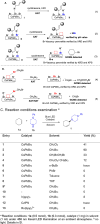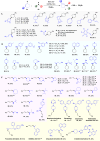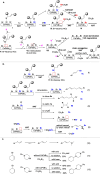Halide Perovskite Induces Halogen/Hydrogen Atom Transfer (XAT/HAT) for Allylic C-H Amination
- PMID: 39231037
- PMCID: PMC11701359
- DOI: 10.1002/anie.202413012
Halide Perovskite Induces Halogen/Hydrogen Atom Transfer (XAT/HAT) for Allylic C-H Amination
Abstract
Allylic C-H amination has emerged as a powerful tool to construct allylamines, common motifs in molecular therapeutics. Such reaction implies an oxidative path for C-H activation but furnishes reductive amines, inferring mild oxidants' inactivity for C-H oxidation but strong oxidants' detriment to products. Herein we report a heterogeneous catalytic approach that manipulates halogen-vacancies of perovskite photocatalyst and exploits halogenated-solvents (i.e. CH2Cl2, CH2Br2) as mild oxidants for selective C-H allyl amination with 19,376 turnovers. CsPbBr3 nanocrystals induce cooperative hydrogen-atom-transfer (HAT, C-H oxidation, and halogen-vacancy CsPbBr3-x formation) and halogen-atom-transfer (XAT, CsPbBr3-x-induced solvent reduction) under a radical chain mechanism. Terminal/internal olefins are amenable to forge aromatic/aliphatic, cyclic/acyclic, secondary/tertiary allylamines (70 examples), including drugs or their derivatives.
Keywords: C−H amination; Halide perovskite; Halogen atom transfer; Hydrogen atom transfer; Photocatalyst.
© 2024 The Authors. Angewandte Chemie International Edition published by Wiley-VCH GmbH.
Conflict of interest statement
A provisional patent application is filing during the manuscript preparation.
Figures




Similar articles
-
The Merger of Benzophenone HAT Photocatalysis and Silyl Radical-Induced XAT Enables Both Nickel-Catalyzed Cross-Electrophile Coupling and 1,2-Dicarbofunctionalization of Olefins.ACS Catal. 2022 Sep 16;12(18):11216-11225. doi: 10.1021/acscatal.2c03805. Epub 2022 Sep 1. ACS Catal. 2022. PMID: 36158902 Free PMC article.
-
Ni-Doped Perovskite for Photocatalytic Benzylic C-H Amination.J Am Chem Soc. 2025 May 21;147(20):17273-17280. doi: 10.1021/jacs.5c03588. Epub 2025 May 8. J Am Chem Soc. 2025. PMID: 40338199
-
Cascade cyclization for the synthesis of indolo[2,1-α]isoquinoline derivatives via visible-light-induced halogen-atom-transfer (XAT) and hydrogen-atom-transfer (HAT).Org Biomol Chem. 2022 Feb 23;20(8):1731-1737. doi: 10.1039/d1ob02480a. Org Biomol Chem. 2022. PMID: 35142329
-
Direct Photocatalyzed Hydrogen Atom Transfer (HAT) for Aliphatic C-H Bonds Elaboration.Chem Rev. 2022 Jan 26;122(2):1875-1924. doi: 10.1021/acs.chemrev.1c00263. Epub 2021 Aug 6. Chem Rev. 2022. PMID: 34355884 Free PMC article. Review.
-
Recent Progress in Steroid C(sp3)-H Functionalization.Chem Rec. 2024 Dec;24(12):e202400150. doi: 10.1002/tcr.202400150. Epub 2024 Nov 20. Chem Rec. 2024. PMID: 39568279 Review.
Cited by
-
Lead-Free Metal Halide Double Perovskite-Photoelectrocatalyzed Activation of C(sp3)‑H Bonds and Alkylation of Alkenes and Azo Compounds.JACS Au. 2025 Jun 16;5(7):3189-3202. doi: 10.1021/jacsau.5c00366. eCollection 2025 Jul 28. JACS Au. 2025. PMID: 40747046 Free PMC article.
-
Merging of Two Photoredox Cycles with One Perovskite Catalyst Achieving Dual Functionalization: N-Heterocyclization and Site-Selective Bromination of N-Arylamines.J Org Chem. 2025 Mar 28;90(12):4244-4253. doi: 10.1021/acs.joc.4c03045. Epub 2025 Mar 13. J Org Chem. 2025. PMID: 40080873 Free PMC article.
-
Highly enantioselective synthesis controlled by spin-exchange interaction.Sci Adv. 2025 Jun 20;11(25):eadw5850. doi: 10.1126/sciadv.adw5850. Epub 2025 Jun 18. Sci Adv. 2025. PMID: 40532001 Free PMC article.
References
Grants and funding
LinkOut - more resources
Full Text Sources

